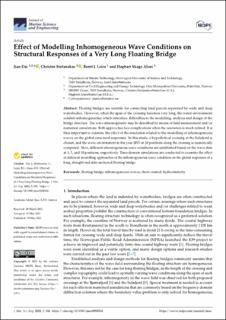| dc.contributor.author | Dai, Jian | |
| dc.contributor.author | Stefanakos, Christos | |
| dc.contributor.author | Leira, Bernt Johan | |
| dc.contributor.author | Alsos, Hagbart Skage | |
| dc.date.accessioned | 2021-06-25T10:48:59Z | |
| dc.date.available | 2021-06-25T10:48:59Z | |
| dc.date.created | 2021-06-07T20:20:24Z | |
| dc.date.issued | 2021-05-19 | |
| dc.identifier.citation | Journal of Marine Science and Engineering. 2021, 9 (5), 2-19). | en_US |
| dc.identifier.issn | 2077-1312 | |
| dc.identifier.uri | https://hdl.handle.net/11250/2761346 | |
| dc.description.abstract | Floating bridges are suitable for connecting land parcels separated by wide and deep waterbodies. However, when the span of the crossing becomes very long, the water environment exhibits inhomogeneities which introduce difficulties to the modelling, analysis and design of the bridge structure. The wave inhomogeneity may be described by means of field measurement and/or numerical simulations. Both approaches face complications when the resolution is much refined. It is thus important to examine the effect of the resolution related to the modelling of inhomogeneous waves on the global structural responses. In this study, a hypothetical crossing at the Sulafjord is chosen, and the wave environment in the year 2015 at 10 positions along the crossing is numerically computed. Next, different inhomogeneous wave conditions are established based on the wave data at 3, 5, and 10 positions, respectively. Time-domain simulations are conducted to examine the effect of different modelling approaches of the inhomogeneous wave condition on the global responses of a long, straight and side-anchored floating bridge. | en_US |
| dc.language.iso | eng | en_US |
| dc.publisher | MDPI | en_US |
| dc.relation.ispartofseries | Journal of Marine Science and Engineering;volume 9, issue 5 | |
| dc.rights | Navngivelse 4.0 Internasjonal | * |
| dc.rights.uri | http://creativecommons.org/licenses/by/4.0/deed.no | * |
| dc.subject | Floating bridges | en_US |
| dc.subject | Inhomogeneous waves | en_US |
| dc.subject | Hydroelasticity | en_US |
| dc.title | Effect of modelling inhomogeneous wave conditions on structural responses of a very long floating bridge | en_US |
| dc.type | Peer reviewed | en_US |
| dc.type | Journal article | en_US |
| dc.description.version | publishedVersion | en_US |
| dc.rights.holder | © 2021 by the authors. | en_US |
| dc.source.articlenumber | 548 | en_US |
| cristin.ispublished | true | |
| cristin.fulltext | original | |
| cristin.qualitycode | 1 | |
| dc.identifier.doi | https://doi.org/10.3390/jmse9050548 | |
| dc.identifier.cristin | 1914303 | |
| dc.source.journal | Journal of Marine Science and Engineering | en_US |
| dc.source.volume | 9 | en_US |
| dc.source.issue | 5 | en_US |
| dc.source.pagenumber | 19 | en_US |
| dc.relation.project | Norges forskningsråd: 268403/O80 | en_US |

